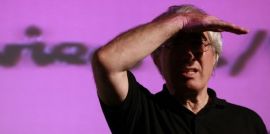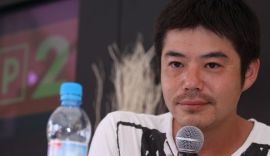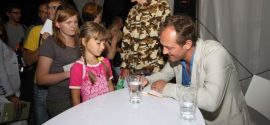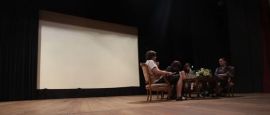Lech Majewski on Beauty…
 Jagna Lewandowska and Maciej Stasiowski talked with Lech Majewski, a versatile artist
Jagna Lewandowska and Maciej Stasiowski talked with Lech Majewski, a versatile artist
J.L.: Some time ago you mentioned that you’re a poet and a painter who makes films. What are the proportions today?
The centre of gravity may have moved a little bit toward painting, but poetry is still important… To tell the truth, I think it’s all the same. Film allows for the marriage of poetry and painting. It allows them to last in time, just like music. Of course the same is with images and poetry, because it takes some time to read a poem or to examine a picture. But it’s still an unspecified, ambiguous process. You can stand in front of an art work in a gallery for two days or two seconds, but the time of a film is defined. And that’s a riddle for philosophers.
J.L.: But you fight with the film linearity, especially in your video works.
Not only in those works. My latest film “The Mill and the Cross”, based on Peter Bruegel’s picture, is also multi-layered. Of course there’s the narration but if someone wanted to explore it, they would discover hidden layers, as described in Michael Gibson’s famous essay ‘BRUEGEL- THE MILL AND THE CROSS’, which will be published in Poland soon. All reproductions in the publication will be printed on silk paper in a special reprographic technique. The second part of the book includes shots from the film, and storyboards are in the third part.
M.S.: Your ‘Blood of a Poet’ installation is a non-linear form by design. Making the film ‘Glass Lips’, which is based on the installation, did you take into account the fact that the film would be incomplete in a way?
You mean the fact that it is shown on 33 screens simultaneously? It’s a Borgesian garden of parting paths. Cortazar wrote his ‘Hopscotch’ in this way, allowing us to read it in at least two different ways. In case of 33 films, the number of narrations you could build is close to infinity. Of course there are some uniting elements: leitmotifs, requisites, symbols or repeated situations taking place in different configurations. Each film has different duration and thus they all can be played until the end of the world and they will never be repeated in the same configuration. Laurence Kardish, the curator of the Museum of Modern Art in New York, once said that if you write poems, there comes a moment when you have to gather them in one volume and create some kind of order- that’s how ‘The Blood of a Poet’ turned into ‘Glass Lips’.
J.L.: So maybe you should publish your next book in Liberature?
In ‘The Mill and the Cross’, which is a multivocal film, building a maze within a closed time was constructively most interesting. Bruegel’s picture is a kind of a philosophical essay. What other artists exposed in the foreground of their paintings, he used to hide in the background. Whether it’s the fall of Icarus, the suicide of Saul or Christ’s passion- it’s all hidden in the maze of mundane reality.
J.L.: Have you got an idea for your next live picture? And while selecting, are you guided by some sort of code, or is it an intuitive, emotional decision?
I have some intimate visions, some visual motifs that I would like to carry out. But I don’t like talking about future. I avoid such conversations because future is very surprising and I don’t want to provoke it.
M.S.: Let’s go back to the theme of parting paths. What is your attitude towards films released on DVDs, where they can be divided into segments, scenes, which then can be watched in any order?
We can navigate between them, but it just serves the purpose of scouring the film. Today we have a different approach to time. Our attention span is getting shorter. People pause a film in order to answer the phone or do something they’ve forgotten to do and then they go back to watching. It’s a different, polyphonic reception of reality- shredding of time and perception. It’s beyond dispute, such is the nature of the world, closely related to the change of attitude towards time and towards the ability to concentrate. In Manhattan I’ve got a TV set with two hundred channels and still there’s nothing to watch, not mentioning the fact that the act of watching is constantly interrupted by the same advertisements. Actually they are more memorable than the film itself. Fellini once said that a film is an unnecessary addition to an advertisement.
J.L.: You made your last films using digital technology and it seems that you’ve mastered it and managed to adapt it for your own use. In one of your interviews you compared a digital camera to a paint brush, putting the digital equipment in opposition to its analogue equivalent. Don’t you sometimes get irritated by the predictability, literality and sharpness of the digital camera?
This sharpness can really help, like it did with my latest film. It grieves me that ‘The Mill and the Cross’ will be shown not only on BlueRay, but also on DVD, because some of the long shots with a range of characters will disappear. The action takes place in 1563, the time of Renaissance in full bloom. A combination of distinct foreground and the depth of field was the characteristic feature of paintings created then. Somewhere behind the shoulder of a man there are distant, perfectly shaped tiny figures. If we take a closer look we can see who the people are and what they are doing. It has always fascinated me. I wondered how I could film a similar scene. When we use wide-angle lens, the foreground is slightly deformed, the background becomes tiny and the details are impossible to decipher. On the other hand the use of long focus lens makes everything that’s close look like it should be but the background is blurred. I remember Orson Welles had such problems. When Gregg Toland shot first scenes and presented them to the director, he asked: “Why is the background so blurred?”. The cameraman explained that this is just the characteristic feature of the lens, but Welles’s childish stubbornness won and they cut the objective, glued the lenses together and achieved what they wanted- sharpness of shots. Thanks to digital technology we can achieve the same effect but in a greater scale. Walles was a film neophyte and thanks to his youthful rowdiness and maximalism he managed to break some of the rules. Today digital technology is endangered by the fact that it’s becoming a tool used almost exclusively for the production of trivial fairy tales.
part 2
J.L.: In your opinion, what tasks are ahead of the modern art? Is one of its duties commenting on current events, or are you an advocate of a turn for the past?
I blame modern art for the death of spirituality and aesthetics, the aesthetics understood as the contact with Beauty that is essential for mental health and enabling to find Arcadia. This sense of beauty was pulverized by the 20th century art. It’s enough to go to modern art galleries to see those monsters, intestines torn apart… When I was in the Museum of Modern Art in New York during the premiere of my album, the director of the museum showed me around the newest exhibition. When I stepped onto a blind lying on the floor, I heard a cry of terror. I thought the thing had fallen off the window, but no- it was a piece of art! Galleries around the world are full of such blinds lying on the floor, of such trash and dirt. It’s the portrayal of the world torn apart by a wild beast of banality.
M.S.: Your works are compared to those created by Matthew Barney…
Yes, we even have the same distributor in the US. He was the one who gave me Barney’s latest film. Indeed, I admire his sculptures, but the film… well, it’s art for art’s sake. I admire such people like Greeneway or Barney because they created a language of their own and managed to find loyal audience. After all, it’s quite an achievement. But I don’t really know their works, I prefer those created by Kentridge or Bill Viola.
J.L.: Have you seen Adam Sikora’s latest film, ‘Expelled’? Two artists connected with you, cooperating on a separate project. One, a cameraman and a friend in the role of the film director, and the other, Krzysztof Siwczyk, known for his role in your film ‘Wojaczek’- this time setting out to adapt Beckett’s works for the screen. Yet they don’t forget the Mikołów legacy…
No, Adam doesn’t show me his films. And I’m glad that Krzysztof is already over the film- Post scriptum to ‘Wojaczek’… Unfortunately, I haven’t seen their film but I’m pleased that mine has been admired for so many years.
M.S.: But you already have your own audience. For example my family loves ‘Angelus’.
When I made ‘Angelus’, it didn’t create much backlash. It didn’t receive any prizes in Gdynia, only the international jury at the Camerimage festival appreciated it. It’s typical- I function much worse in Poland than anywhere else.
M.S.: In the dialogue stem to ‘Angelus’ a Silesian dialect was used. Have you ever thought of working on folk tales?
I was born in Stalinogród, that is in Katowice, only thanks to Gustaw Morcinek the name of this city had been changed for three years. I remember old ladies wearing aprons, I remember horses and wagons with coal. All my primary school friends used perfect Silesian dialect; playing with them I was able to master their language perfectly. So for me ‘Wojaczek’ was a journey into the fascinations of my youth, just like ‘Angelus’ was the return to pictures from my cihldhood. It’s amazing- I see my teenage youth in black and white, but halcyon years of my childhood are a blaze of colors- ORWO technicolor.
When I saw Manhattan for the first time in 1981, I went for a walk in the Central Park and saw huge sunlight-flooded houses, I felt strange- they were just like the houses I watched as a child in Katowice. They regained proportions from that time. I felt like a four-year-old again. I also remember that when I came to my family home after nine years od absence, I experienced the same unusual feeling. What had been functioning in my memory as huge, seemed tiny. Now I visit my mum more often and the rooms have magically widened again. But space isn’t the only thing that has its bizarre swirls. I met Michael Hausman in New York not so long ago. He produces films directed by Miloš Forman or Martin Scorsese. He also produced my American debut film, ‘Flight of the Spruce Goose’. It was 25 years ago and we hadn’t seen each other since then. We sat in a bar and I had a feeling that it had only been three months since we last met. On the other hand, when I recall things that happened a year ago, I feel as if they happened seven years ago. Time and space are constantly bending, bulging and deforming just like reflections from deformed mirrors. I’ve already been a couple of times in Kazimierz and it would seem that getting around this town stretching along the Vistula river is as easy as anything. But I constantly get lost and I always discover new dimensions of houses, squares and streets here.
J.L.: Do you think Kazimierz has magical potential? Could a film like ‘Angelus’ be made here?
It’s difficult to tell. I always come here in high season, when there are lots of tourists. It’s quite ovelwhelming, drowning. If I was supposed to experience some kind of magic, it would have to be a more quiet place.
J.L.: Is every filmmaker an unfulfilled critic?
Am I an unfulfilled critic? No… somehow I’ve never had such a need. If I ever wrote about films, it was about the ones that moved me. I tried to analyze the fragments that worked as a metalanguage, that touched me. I wrote about different films, for example about Fellini’s ’8 ½‘. I spent 2 months working on it in the cutting room at Lodz Film School, sleeping on a camp bed. There weren’t any DVDs then. But today I would also choose the editing table, because only this way you can count frames, see parts of the film stock that had been glued together. Although I examined the film very carefully, it still concealed a lot. That’s the phenomenon of great films- no matter how many intellectual nails you would hammer into the table to tan their essence, it always slips away. It’s a constant flight of this ‘thing’, of this spiritual substance, pneuma, transcendence or imponderabilia with tendencies of Ariel. A prankish spirit that won’t let you pin it (laughs). Amazingly, those ghosts floating above works of art are the most durable media. They’re as if in accordance with Plato’s philosophy. Physicality of these works is sometimes brittle, fragile and faded, but their spiritual essence is more long-lasting than tungsten. Some years ago I decided to read ‘The Divine Comedy’ in two versions- Polish (comparing two translations) and English (three versions- one written in blank verse and two rhymed). I gathered some books about each poem, I waded through all of them at the pace of more or less one part a year. And everything I learned about the uncanny ‘space’ of this masterpiece was kind of hidden between the lines. If you read Dante in a usual way, you only graze the surface, characters, situations…
J.L.: A text only signalizes…
Yes, a text is just like semaphores, It’s like reading Eliot, only he often put footnotes. He forces the reader to follow his inspirations. Lately I bought a volume in New York- a fascimile of the manuscript, or rather of the typescript of ‘The Waste Land’. It’s the original typescript, with all corrections- 200 pages, each photographed in 1:1 scale. Here you can see the author’s work. If only we could get Wojaczek’s poems and print the fascimiles together with his annotations. Then we could see how this unusual poet worked, where he searched for inspirations. Borgues put a lot of effort in touching up his texts. In his poems each metaphor is beautiful… And again, on Beauty!
J.L.: So let’s get back to the earth. Thank you very much for the conversation!









